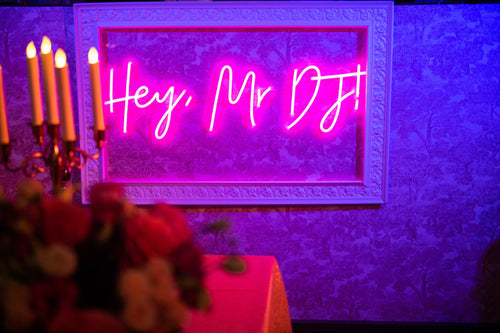Custom LED signs have become an essential part of modern signage solutions, offering a dynamic, eye-catching, and versatile way to convey messages. Whether used for business advertising, personal use, or public communication, LED signs have revolutionized how information is presented. This comprehensive guide explores what custom LED signs are, how they work, their benefits, potential drawbacks, and key considerations when incorporating them into various applications.
What Are Custom LED Signs?
LED neon signs are digital displays that use light-emitting diodes (LEDs) to create vibrant and customizable messages. These signs can be designed to show text, images, animations, or videos, depending on the system's complexity. "Custom LED signs" refers to the fact that the message, design, and features of the sign can be tailored to suit the specific needs of the user, whether that’s a business, event organizer, or personal space.
There are two primary types of LED signs:
-
Monochrome LED Signs: These signs typically display text or simple images in one color, usually red, white, or green. They are often used for straightforward communication such as time, temperature, or simple promotional messages.
-
Full-Color LED Signs: These signs can display a broad spectrum of colors and are much more versatile. They are capable of showing dynamic content, such as videos, animations, and rich graphics. Full-color LED displays are commonly used in larger installations like billboards, outdoor displays, or large storefront signs.
Custom LED signs are built to meet the specific requirements of the user, allowing for easy messaging updates, integrations with other systems, and the ability to stand out in a crowded environment.
How Do Custom LED Signs Work?
The functionality of LED signs is based on the technology behind light-emitting diodes. Each LED is an electronic component that emits light when an electrical current passes through it. LED signs consist of multiple individual LEDs arranged in a grid, with each LED producing light of varying brightness and color. These signs are often controlled by a microprocessor or a computer that allows the user to program the content displayed on the sign.
There are a few key components that make custom LED signs work:
-
LED Modules: These are the individual panels that contain multiple LEDs arranged in a matrix. Each module can display a small portion of the overall message or image.
-
Control Systems: Custom LED signs use control systems, often a software interface, to allow users to create, edit, and schedule messages. Control systems can be remote-controlled, connected to the internet, or integrated into a central system that allows for easy management of multiple signs.
-
Power Supply: Since LEDs require a steady power supply to function efficiently, these signs are typically powered by either AC or DC power sources. The power requirement can vary depending on the size and complexity of the sign.
-
Connectivity: Many modern custom LED signs come with wireless or internet connectivity, allowing remote updates and real-time content management. This can be particularly useful for businesses that want to change their messages frequently.
Benefits of Custom LED Signs

Custom LED signs offer a range of advantages that make them a popular choice for a variety of applications. Some of the key benefits include:
1. High Visibility and Attention-Grabbing
LED signs are highly visible even from a distance due to their bright, vibrant light output. The ability to display colorful, dynamic content such as moving text, images, or animations ensures that the sign grabs the attention of passersby. This is particularly advantageous for businesses that want to attract customers in crowded areas.
2. Cost-Effective Advertising
While the initial investment in custom LED signs can be significant, their long-term cost-effectiveness is undeniable. Traditional advertising methods, such as billboards, flyers, or print media, often require continuous payments, whereas LED signs can be used for years with minimal maintenance. Furthermore, businesses can update their messages instantly without incurring extra costs.
3. Energy Efficiency
LED technology is known for its energy efficiency. LED neon signs consume significantly less power than traditional neon or incandescent signs, making them more environmentally friendly and reducing the operational costs for the user.
4. Customizability
Custom LED signs can be tailored to meet the unique needs of the user. The sign can be programmed to display a wide range of content, including time-sensitive messages, promotions, and emergency alerts. Business owners can change their messages at any time without having to replace the entire sign, providing flexibility in communication.
5. Durability and Longevity
LED signs have a longer lifespan compared to traditional signs, such as neon or fluorescent lighting. With proper care and maintenance, an LED sign can last tens of thousands of hours. This reduces the need for frequent replacements, making them a cost-effective long-term investment.
6. Weather Resistance
Outdoor LED signs are built to withstand various weather conditions, such as rain, snow, or extreme temperatures. This makes them suitable for year-round use, regardless of the location.
7. Interactivity
Some advanced custom LED signs can integrate touchscreens or motion sensors, allowing for interactive features. This can be useful in certain applications, such as wayfinding or self-service kiosks, where customers can interact directly with the sign to retrieve information or make selections.
Considerations When Using Custom LED Signs
While custom LED signs have numerous benefits, there are also considerations to keep in mind before making a purchase. It’s essential to take into account various factors that can affect the performance, cost, and overall effectiveness of the sign.
1. Initial Investment
The upfront cost of a custom LED sign can be higher than traditional signage. This includes the cost of the sign itself, installation, and any necessary accessories (such as control systems or software). However, as previously mentioned, the long-term savings often outweigh the initial investment due to their durability and energy efficiency.
2. Content Management
For businesses that plan to display frequently changing content, the ability to easily update the sign is crucial. Custom LED signs typically come with software that allows users to control and schedule messages. It's essential to ensure that the software is user-friendly and compatible with the system. In some cases, businesses may need to hire technical support or purchase additional equipment.
3. Size and Placement
When choosing a custom LED sign, it’s important to consider its size and placement. A sign that’s too small may not attract attention, while one that’s too large may be overpowering and costly. Understanding the environment in which the sign will be placed — whether it's an indoor or outdoor setting — will help determine the appropriate size, brightness, and features.
4. Maintenance and Upkeep
Although LED signs are low-maintenance, they do require some level of care to ensure optimal performance. Dust or debris can accumulate on the surface, affecting visibility. Regular cleaning and occasional software updates may be necessary to keep the sign functioning at its best.
5. Local Regulations
Before installing an LED sign, it’s important to be aware of any local laws or zoning regulations regarding signage. Some areas may have restrictions on the size, brightness, or content displayed on signs, particularly in outdoor environments. Consulting with a professional or local authorities before installation can help avoid legal complications.
6. Target Audience
The effectiveness of an custom LED signs depends on how well it resonates with its target audience. For example, a brightly colored, dynamic LED sign may work well in a bustling urban area but could be overwhelming in a quieter suburban setting. Understanding the target demographic and location is key to selecting the right type of sign and message.
7. Environmental Impact
Although LED signs are energy-efficient, they still require electrical power to operate. Businesses should consider sourcing renewable energy or implementing energy-saving measures to further reduce the environmental impact.
Applications of Custom LED Signs
Custom LED signs are used in a wide range of industries and settings, including:
- Retail Stores: To promote sales, display product information, or show the store’s hours.
- Restaurants: To advertise specials, display menus, or create an ambiance.
- Events: For showcasing schedules, directions, or advertising for conferences, trade shows, or festivals.
- Transportation: In airports, train stations, or bus stops to provide real-time updates on arrivals, departures, and schedules.
- Public Spaces: In parks, sports stadiums, or city centers to display messages to the public.
- Residential Areas: As personalized displays, for example, in home entrances or private events.
Conclusion
Custom LED signs are a versatile, eye-catching, and energy-efficient solution for businesses and individuals looking to communicate effectively and dynamically. The ability to customize content, combine text with images or animations, and manage content remotely offers users a significant advantage over traditional signage methods. By carefully considering factors like cost, content management, and regulatory compliance, users can maximize the effectiveness and longevity of their custom LED signs, making them a worthwhile investment for a variety of purposes.




